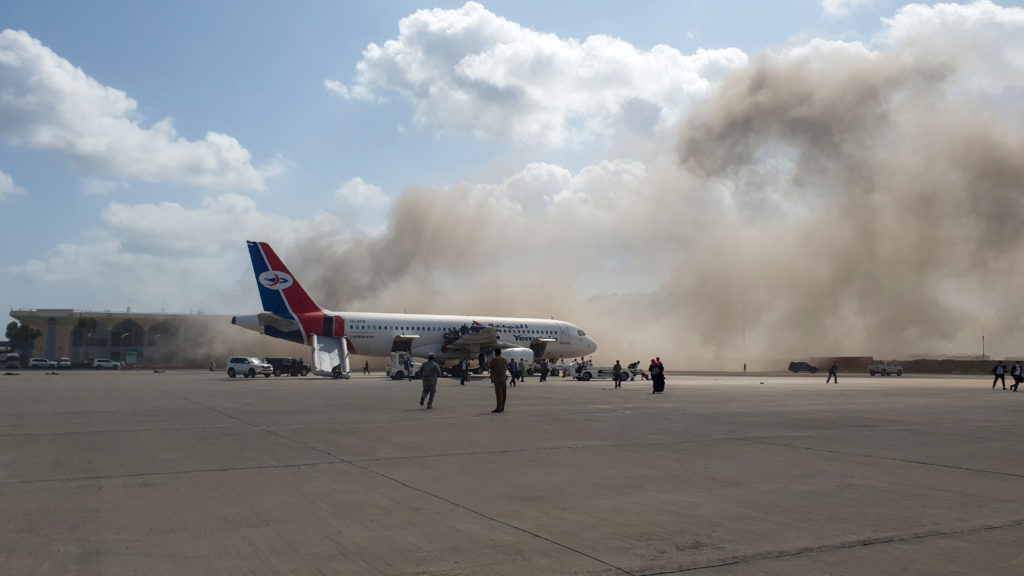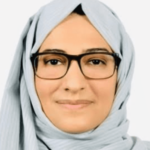In Yemen, when you hear of a journalist’s death, the first question that arises is: “Who killed him?” It is as if our memories, filled with images of violent death, no longer have room for a traditional death – the kind that visits you quietly while you lie in your bed. We have replaced a tranquil death with one laced with blood and bullets. In Yemen, we not only dream of living in peace, we dream of dying in peace too.
“I arrived at Aden airport on December 30 at around 9 in the morning, and it was already very crowded,” said Majed Al-Shuaibi, editor-in-chief of Yemen’s The Fourth Dimension website. “I felt very optimistic about the new government being on its way to Aden, which meant a return of services to the city and the revival of life. We had built our hopes on a return of government.”

Yet, although optimistic, he was also anxious.
“I was afraid of being targeted,” he explained.
And that is exactly what happened.
“The first missile exploded and then a minute or so later the second hit the platform where the journalists were lined up with their equipment,” he continued. “After a third explosion, I saw soldiers firing heavily and people running in panic among the dead bodies. Then I saw that the government was going to leave, and felt overwhelmed with despair.” According to Yemeni Health Minister Dr. Qassem Buhaibh, the three bombings left 135 people dead and many more wounded. Among the dead was Belqis TV correspondent Adeeb Al-Janani.
“I was sitting next to Adeeb,” said Majed. “When the bombing started, we ran away. Later I saw him from afar, swaying and falling to the ground.”
Paramedic Journalists
Salah Al-Aqil, correspondent for Russia Today in Aden, vividly remembered the details of the bloody day. “The plane landed and Brigadier General Shalal Ali Shaya, the former Aden Security Director, got off first,” Salah told Daraj. “Then, the first missile hit the Al-Zafaran hall, which was intended to receive the new government members, before a second and third exploded. I ran in search of a safe place to hide.”
The whole of Yemen has become an open battlefield. Death crouches in the corners of ordinary events, even when it comes to journalists covering a party or press conference.
Salah found himself becoming a medic.
“I saw someone who appeared to have a broken leg,” he said. “I carried him, and later learnt he was Badr Al-Salahi, the undersecretary at the Ministry of Culture. “We managed to help him, and also rescued a fellow journalist who was in a state of severe shock. I saw about five charred bodies. The scale of the destruction was immense.”
It was not the first time that Salah had faced death. Death approached him more than five times, which includes the severe threats he received following the assassination of his friend, Nabil Al-Quaiti, a cameraman and AFP photographer assassinated by unknowns near his home in Aden in June 2020.
“After Nabil was assassinated, I received threatening letters, ordering me and my family to leave Yemen, but I refused,” Salah said. “If everyone who was threatened left the country, there would be no one left.”
Dalil Yusef, correspondent for Yemen Today, also transformed into a medic. “I was broadcasting a report about the government arriving by air and right at the end of my segment I heard the sound of an explosion,” Dalil explained. “The panic that ensued made it difficult to immediately grasp what had happened. My colleague, Salah Al-Aqel, yelled at me to get an ambulance. We did not find one. So we had to transport the injured on the carriages that usually carry the passengers’ bags. Of course, I did not expect this to happen and was not prepared at all. I went to cover a normal event, but then found myself in the middle of a battlefield.”
A Moment of Motherhood Under Fire
“After the first missile exploded, I spotted one of the coalition soldiers with shrapnel in his face, which hit me with indescribable horror,” said freelance journalist Alia Fouad. “Then heavy gunfire erupted. I felt trapped between the missiles from the air and the bullets on the ground. I was screaming and started running hysterically. When I got to a coalition armored vehicle, I fainted.”
Her colleagues helped her hide in a safe spot.
“After I woke up, I thought of my son,” she continued. “I was afraid that he would see the news on TV, so I sent him a reassuring message, saying: ‘I’m fine, there was a bombing at the airport, we’re surrounded, but I’m fine.’” This was shortly after the explosion. Yet, despite the horror around her, she did not forget to stress her son should have his lunch.
“My son insists I should quit journalism,” she said. “But I assure him that I’ve escaped death more than once, so there is no need to worry.”
Occupational Safety as a Shared Responsibility
None of the interviewed journalists attended courses in occupational safety and security. In 2020, three journalists were killed, bringing the total number of those killed since the beginning of the war in 2015 to 46, according to statistics of the Yemeni Journalists Syndicate (YJS).
Mahmoud Thabet, head of the YJS branch in Aden, said in an interview that the professional safety of journalists was a shared responsibility of both media institutions and the journalists themselves.
“When institutions assign journalists to cover events in a conflict zone like Yemen, they should make sure that they have sufficient awareness and training in the field of occupational safety and first aid,” he said. The remaining responsibility rests on the shoulders of the journalist.
“Many journalists are motivated by their enthusiasm, which is often a precedent for negligence in applying the principles of occupational safety,” said Thabet He cited examples of journalists throwing themselves into the chaos of crowds or venturing out to places of armed clashes without thinking about the consequences, adding that: “caution is one of the first principles of safety.”
He also stressed the need for a journalist to practice his work professionally, and to be concerned with reporting the truth only, away from bias towards any of the parties involved, so that he does not end up being a target due to internal politics.
“Many journalists are motivated by their enthusiasm, which is often a precedent for negligence in applying the principles of occupational safety.”
Thabet further explained that the YJS in coordination with the International Federation of Journalist organized three workshops on occupational safety and first aid. They included talks on psychological well-being, and how journalists should deal with the effects of Near-Death Experience (NDE), trauma and survival. Nevertheless, he believed those courses were not enough, but there are plans to offer more in 2021.
Being a journalist in Yemen has turned into a game of tag with death. Danger is no longer confined to a raging battlefield. Rather the whole of Yemen has become a open battlefield.
Read Also:
No posts






